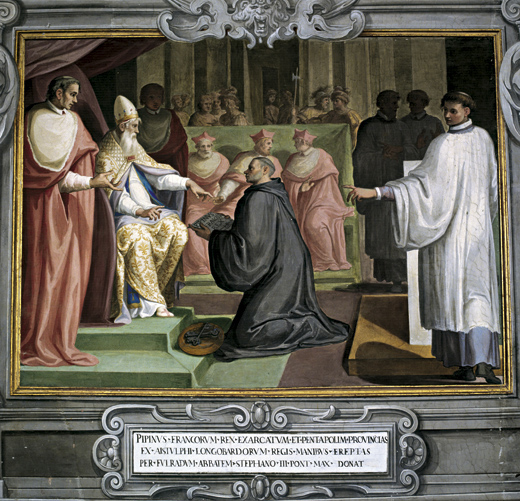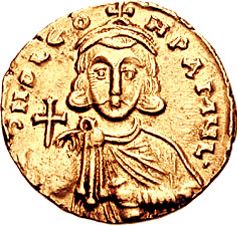|
Papal Apocrisiarius
The ''apocrisiarius'' or apocrisiary was the legate from the pope to the patriarch of Constantinople, circa 452–743, equivalent to the modern nunciature. Nomenclature The term ''apocrisiarius'' comes from the Greek word ''apokrisis'', "response". The Latin language name for the office would have been ''responsalis'', from the word ''responsum''. The term was also used by other ecclesiastical envoys, either between bishops or between a bishop and a royal court, although this specific office was one of the first and most notable examples. History and functions In part, the role of the ''apocrisiarius'' was to represent the interests of the Roman church at the imperial court in Constantinople.Ekonomou, 2007, p. 8. Relations between the pope and the Byzantine Empire were also managed at the court of the Exarchate of Ravenna—where the pope had another permanent ''apocrisiarius''—and between the archbishop of Ravenna and the papacy. The later had a special role as ''responsali ... [...More Info...] [...Related Items...] OR: [Wikipedia] [Google] [Baidu] |
Papal Legate
300px, A woodcut showing Henry II of England greeting the pope's legate. A papal legate or apostolic legate (from the ancient Roman title ''legatus'') is a personal representative of the pope to foreign nations, or to some part of the Catholic Church. He is empowered on matters of Catholic faith and for the settlement of ecclesiastical matters. The legate is appointed directly by the pope—the bishop of Rome and head of the Catholic Church. Hence a legate is usually sent to a government, a sovereign or to a large body of believers (such as a national church) or to take charge of a major religious effort, such as an ecumenical council, a crusade to the Holy Land, or even against a heresy such as the Cathars. The term ''legation'' is applied both to a legate's mandate and to the territory concerned (such as a state, or an ecclesiastical province). The relevant adjective is ''legatine''. History 200px, Cardinal Thomas Wolsey, papal legate to England during the reign of Hen ... [...More Info...] [...Related Items...] OR: [Wikipedia] [Google] [Baidu] |
Constantinople
la, Constantinopolis ota, قسطنطينيه , alternate_name = Byzantion (earlier Greek name), Nova Roma ("New Rome"), Miklagard/Miklagarth (Old Norse), Tsargrad ( Slavic), Qustantiniya (Arabic), Basileuousa ("Queen of Cities"), Megalopolis ("the Great City"), Πόλις ("the City"), Kostantiniyye or Konstantinopolis ( Turkish) , image = Byzantine Constantinople-en.png , alt = , caption = Map of Constantinople in the Byzantine period, corresponding to the modern-day Fatih district of Istanbul , map_type = Istanbul#Turkey Marmara#Turkey , map_alt = A map of Byzantine Istanbul. , map_size = 275 , map_caption = Constantinople was founded on the former site of the Greek colony of Byzantion, which today is known as Istanbul in Turkey. , coordinates = , location = Fatih, İstanbul, Turkey , region = Marmara Region , type = Imperial city , part_of = , length = , width ... [...More Info...] [...Related Items...] OR: [Wikipedia] [Google] [Baidu] |
Marcian
Marcian (; la, Marcianus, link=no; grc-gre, Μαρκιανός, link=no ; 392 – 27 January 457) was Roman emperor of the East from 450 to 457. Very little of his life before becoming emperor is known, other than that he was a (personal assistant) who served under the commanders Ardabur and his son Aspar for fifteen years. After the death of Emperor Theodosius II on 28 July 450, Marcian was made a candidate for the throne by Aspar, who held much influence because of his military power. After a month of negotiations Pulcheria, Theodosius' sister, agreed to marry Marcian. Zeno, a military leader whose influence was similar to Aspar's, may have been involved in these negotiations, as he was given the high-ranking court title of patrician upon Marcian's accession. Marcian was elected and inaugurated on 25 August 450. Marcian reversed many of the actions of TheodosiusII in the Eastern Roman Empire's relationship with the Huns under Attila and in religious matters. Marcian ... [...More Info...] [...Related Items...] OR: [Wikipedia] [Google] [Baidu] |
Pope Leo I
Pope Leo I ( 400 – 10 November 461), also known as Leo the Great, was bishop of Rome from 29 September 440 until his death. Pope Benedict XVI said that Leo's papacy "was undoubtedly one of the most important in the Church's history." Leo was a Roman aristocrat, and was the first pope to have been called "the Great". He is perhaps best known for having met Attila the Hun in 452 and persuaded him to turn back from his invasion of Italy. He is also a Doctor of the Church, most remembered theologically for issuing the Tome of Leo, a document which was a major foundation to the debates of the Council of Chalcedon, the fourth ecumenical council. That meeting dealt primarily with Christology and elucidated the orthodox definition of Christ's being as the hypostatic union of two natures, divine and human, united in one person, "with neither confusion nor division". It was followed by a major schism associated with Monophysitism, Miaphysitism and Dyophysitism. He also contributed signi ... [...More Info...] [...Related Items...] OR: [Wikipedia] [Google] [Baidu] |
Charlemagne
Charlemagne ( , ) or Charles the Great ( la, Carolus Magnus; german: Karl der Große; 2 April 747 – 28 January 814), a member of the Carolingian dynasty, was King of the Franks from 768, King of the Lombards from 774, and the first Holy Roman Emperor, Emperor of the Romans from 800. Charlemagne succeeded in uniting the majority of Western Europe, western and central Europe and was the first recognized emperor to rule from western Europe after the fall of the Western Roman Empire around three centuries earlier. The expanded Frankish state that Charlemagne founded was the Carolingian Empire. He was Canonization, canonized by Antipope Paschal III—an act later treated as invalid—and he is now regarded by some as Beatification, beatified (which is a step on the path to sainthood) in the Catholic Church. Charlemagne was the eldest son of Pepin the Short and Bertrada of Laon. He was born before their Marriage in the Catholic Church, canonical marriage. He became king of the ... [...More Info...] [...Related Items...] OR: [Wikipedia] [Google] [Baidu] |
East–West Schism
The East–West Schism (also known as the Great Schism or Schism of 1054) is the ongoing break of communion between the Roman Catholic and Eastern Orthodox churches since 1054. It is estimated that, immediately after the schism occurred, a slim majority of Christians worldwide were Eastern Christians comprised; most of the rest were Western Christians. The schism was the culmination of theological and political differences between Eastern and Western Christianity that had developed during the preceding centuries. A series of ecclesiastical differences and theological disputes between the Greek East and Latin West preceded the formal split that occurred in 1054. Prominent among these were the procession of the Holy Spirit (''Filioque''), whether leavened or unleavened bread should be used in the Eucharist, the bishop of Rome's claim to universal jurisdiction, and the place of the See of Constantinople in relation to the pentarchy. In 1053, the first action was taken th ... [...More Info...] [...Related Items...] OR: [Wikipedia] [Google] [Baidu] |
Syncellus
''Synkellos'' ( el, σύγκελλος), latinized as ''syncellus'', is an ecclesiastical office in the Eastern Rite churches. In the Byzantine Empire, the ''synkellos'' of the Ecumenical Patriarch of Constantinople was a position of major importance in the state, and often was regarded as the successor-designate to the reigning patriarch. The term is Greek and means "one who lives in the same cell" in a monastery. It is attested from the 5th century onward for the closest advisor of a bishop or archbishop, who then lived in the same residence or cell. In the Byzantine Empire, the ''synkellos'' of the Patriarch of Constantinople quickly acquired a pre-eminent position, and it often happened that a ''synkellos'' succeeded to the patriarchal throne when it fell vacant. This was certainly the expectation by the 9th–10th centuries, when the ''synkellos'' was an official appointed by the Emperor, and became a tool for imperial control of the patriarchal succession. Thus, although its ... [...More Info...] [...Related Items...] OR: [Wikipedia] [Google] [Baidu] |
Pope Stephen II
Pope Stephen II ( la, Stephanus II; 714 – 26 April 757) was born a Roman aristocrat and member of the Orsini family. Stephen was the bishop of Rome from 26 March 752 to his death. Stephen II marks the historical delineation between the Byzantine Papacy and the Frankish Papacy. During Stephen's pontificate, Rome was facing invasion by the Lombards when Stephen II went to Paris to seek assistance from Pepin the Short. Pepin defeated the Lombards and made a gift of land to the pope, eventually leading to the establishment of the Papal States. Election In 751, the Lombard king Aistulf captured the Exarchate of Ravenna, and turned his attention to the Duchy of Rome.Mann, Horace. "Pope Stephen (II) III." The Catholic Encyclopedia Vol. 14. New York: Robert Appleton Company, 1912. 12 September 2017 [...More Info...] [...Related Items...] OR: [Wikipedia] [Google] [Baidu] |
Pope Zacharias
Pope Zachary ( la, Zacharias; 679 – March 752) was the bishop of Rome from 28 November 741 to his death. He was the last pope of the Byzantine Papacy. Zachary built the original church of Santa Maria sopra Minerva, forbade the traffic of slaves in Rome, negotiated peace with the Lombards, and sanctioned Pepin the Short's usurpation of the Frankish throne from Childeric III. Zachary is regarded as a capable administrator and a skillful and subtle diplomat in a dangerous time. Early career Zachary was born into a family of Greek origin, in the Calabrian town of Santa Severina. He was most probably a deacon of the Roman Church and as such signed the decrees of the Roman council of 732. He was selected to succeed Gregory III as pope on 3 December or 5 December 741. Pontificate Gregory III's alliance with the Lombard Duchy of Spoleto put papal cities at risk when the dukes of Spoleto and Benevento rebelled. Zachary turned to King Liutprand the Lombard directly. Out of respect ... [...More Info...] [...Related Items...] OR: [Wikipedia] [Google] [Baidu] |
Pope Gregory III
Pope Gregory III ( la, Gregorius III; died 28 November 741) was the bishop of Rome from 11 February 731 to his death. His pontificate, like that of his predecessor, was disturbed by Byzantine iconoclasm and the advance of the Lombards, in which he invoked the intervention of Charles Martel, although ultimately in vain. He was the last Pope to seek the consent of the Byzantine exarch of Ravenna for his election, and the last non-European pope until the election of Pope Francis on 13 March 2013, more than 1,271 years later. Election Gregory was the son of a Syrian named John. He was elected pope by popular acclamation on 11 February 731, but was not formally consecrated as bishop of Rome until 18 March, after having received the approval of the Byzantine exarch of Ravenna. He was the last pope to seek the exarch’s ratification of a papal election. Iconoclasm Immediately upon his accession, Gregory appealed to Emperor Leo III to moderate his position on iconoclasm. When Gregory' ... [...More Info...] [...Related Items...] OR: [Wikipedia] [Google] [Baidu] |
Pope Gregory II
Pope Gregory II ( la, Gregorius II; 669 – 11 February 731) was the bishop of Rome from 19 May 715 to his death.Mann, Horace. "Pope St. Gregory II." The Catholic Encyclopedia Vol. 6. New York: Robert Appleton Company, 1909. 18 September 2017 His defiance of Emperor as a result of the in the Eastern Empire prepared the way for a long series of revolts, schisms, and civil wars that eventually led to the establishment of the [...More Info...] [...Related Items...] OR: [Wikipedia] [Google] [Baidu] |

.jpg)




